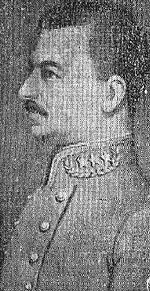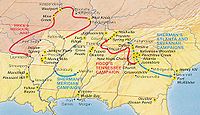- Colton Greene
-
Colton Greene 
Colton GreeneBorn July 7, 1833
South CarolinaDied September 23, 1900
Memphis, TennesseePlace of burial Elmwood Cemetery in Memphis Allegiance United States of America
Confederate States of AmericaService/branch Confederate States Army Years of service 1861–65 Rank Brigadier General Battles/wars American Civil War Colton Greene (July 7, 1833 – September 23, 1900) was an American businessman and soldier. He served as a Confederate general during the American Civil War, mostly leading cavalry units. After the war he perused several successful civic projects and public functions in Tennessee.
Contents
Early life and career
Colton Greene (real name possibly George Colton Greene) was born July 7, 1833 in SC, according to his postwar application for a passport.[1] Little is known of his parents or education, and he reportedly never married nor would discuss his past with anyone. One story, current in Memphis at the time, has it that he killed a man in South Carolina, and then came west. By 1857 he was living in St. Louis, Missouri, where he was involved in politics with the state's Democratic Party. Greene was a wealthy and successful wholesale grocer in St. Louis by 1860.[2] Also that year Greene became a partner in the St. Louis firm of Hoyt & Co.[3]
Civil War service
Choosing to follow the Confederate cause, Greene was active in the pro-secession movement in the border state of Missouri just before the American Civil War began.[2] He was assigned as an aide-de-camp to Governor Claiborne Fox Jackson in 1861,[4] and helped him to coordinate the activities of the secessionists.[2]
Greene was appointed a captain in the Missouri State Guard in 1861, and was sent by Jackson along with Capt. Basil W. Duke to Montgomery, Alabama, (then capital of the Confederacy) to ask the recently-elected Confederate President Jefferson Davis for artillery. It was hoped these guns could be used to attack the Federal arsenal in St. Louis, however the captains arrived with their artillery too late to help in the effort, and the cannon were captured by Union troops. Despite this setback, Greene soon afterwards aided Gov. Jackson to drill recruits that had gathered in Jefferson City, as well as missions that summer into Arkansas and to Richmond, Virginia, to seek support for invading and reclaiming Missouri, now increasingly under Union control.[2]
On August 10, 1861, Greene saw his first combat when he served on the staff of Brig. Gen. James H. McBride during the Battle of Wilson's Creek near Springfield, Missouri. On October 28, Greene was appointed colonel in the Missouri State Guard and assigned as assistant adjutant to the Confederate 7th District in Missouri, commanded by McBride. When that commander fell ill in early 1862, Greene was ordered to lead the district, which he re-organized into a brigade consisting of two volunteer regiments.[2] His brigade participated in the Confederate defeat during the Battle of Pea Ridge on March 7–8 near Bentonville, Arkansas. In the battle, Greene's command was part of Maj. Gen. Sterling Price's Division in Maj. Gen. Earl Van Dorn's army.[5] Sometime during 1861, Greene was also appointed a brigadier general in the Missouri State Guard.[4]
After the fight at Pea Ridge, Greene accompanied Price's force into Mississippi that spring. He requested and received permission to re-enter Missouri to gather recruits, and by the fall he had collected and trained a mounted force. Named the 3rd Missouri Cavalry, Greene was appointed its colonel in the regular Confederate Army on November 4, 1862.[2] Greene led the 3rd Missouri (part of Gen. John S. Marmaduke's division of the Army of the West) at the Battle of Clark's Mill on November 7 at Vera Cruz, located about ten miles southeast of Ava in Douglas County, Missouri.[6]
In 1863, Greene led Marmaduke's cavalry brigade (including the 3rd Missouri) during the Union victory at the Battle of Helena in Phillips County, Arkansas, on July 4.[2] Green then participated during the battles of the 1864 Red River Campaign in the Trans-Mississippi Theater. He fought in the Camden Expedition and the Battle of Poison Spring around Lee Plantation, about 10 miles from Camden, Arkansas, on April 18, 1864. His command was in reserve in the action and entered a hole in the Confederate line that was caused by Union artillery fire. Greene plugged that hole and sealed the victory, routing the remaining Union defensive line. This fight is noted for accusations of the murdering of wounded Federal United States Colored Troops as they surrendered, left behind when the Union forces retreated.[7]
Greene led his brigade[8] (part of Marmaduke's Division in Edmund Kirby Smith's Army of Arkansas) during the Battle of Jenkins' Ferry in Grant County, Arkansas, on April 30, 1864. In the Confederate loss, Greene reported a casualty total of 50; seven dead and 43 wounded.[9] During the time Green was leading a brigade in 1864 he was an acting brigadier general in the Confederate States Army.[4]
On June 6, 1864, Greene fought during the Battle of Old River Lake in Chicot County, Arkansas. At Ditch Bayou Greene attempted unsuccessfully to delay Union forces that were approaching Lake Village, and then he withdrew to nearby Parker's Landing. Total Confederate casualties in the loss, including Greene's soldiers, was reportedly 100 men.[10] Later that summer Greene was arrested and charged with disobeying orders, accused of failing to surrender his mules to the Confederate government. In the ensuing court-martial that fall, he was exonerated of the charges and returned to his command. After the trial, Greene fought during Sterling Price's unsuccessful 1864 Missouri Expedition, better known as Price's Raid. Marmaduke had been promoted and his brigade went to Brig. Gen. John B. Clark, leaving Greene to lead the 3rd Missouri Cavalry once more. When Clark was given divisional command after the raid, Greene again led a brigade.[11]
Postbellum
When the war ended in 1865, Green returned to his life in St. Louis. There he found that his former partner, Stephen Hoyt, and others had seized his business interests and property, leaving Greene in poverty. He then moved to Memphis, Tennessee, to rebuild, taking up work as a banker and an insurance agent for Memphis office of the Knickerbocker Life insurance Co. of New York. Greene established his own insurance firm in 1871 and soon prospered. He then founded the State Savings Bank of Memphis,[3] as well as organizing support in 1886 for the city's first municipal waterworks with the publication of the Report on a Public Water Supply for the City of Memphis, February 23, 1886, which he edited.[4] Greene arranged the first Memphis Mardi Gras (described as "highly successful") and also helped found the Memphis Public Library.[3]
Greene died in Memphis in the fall of 1900, and was buried there in Elmwood Cemetery.[4]
See also
References
Print
- Allardice, Bruce S., Confederate Colonels, University of Missouri Press, 2008.
- Allardice, Bruce S., More Generals in Gray, Louisiana State University Press, 1995, ISBN 0-8071-3148-2.
- Eicher(1), David J., The Longest Night: A Military History of the Civil War, Simon & Schuster, 2001, ISBN 0-684-84944-5.
- Eicher(2), John H., and Eicher, David J., Civil War High Commands, Stanford University Press, 2001, ISBN 0-8047-3641-3.
Online
- www.nps.gov National Park Service description of the Battle of Old River Lake.
- civilwarlandscapes.org Civil War Landscapes casualties from the Battle of Jenkins' Ferry.
- www.watersheds.org Watersheds site description of the Battle of Clark's Mill.
References
- ^ Allardice, "Confederate Colonels". Allardice, "More Generals", p. 105. "The 1854-55 St. Louis Directory shows a 'George C. Green' of Hoyt & Co., the firm of which Colton Greene was a partner in 1860. It is probable that the George C. Green who worked for this small firm in 1854 was the Colton Greene who was a partner in 1860, in which case Greene's real name would appear to be George Colton Greene."
- ^ a b c d e f g Allardice, "More Generals", p. 104.
- ^ a b c Allardice, "More Generals", p. 105.
- ^ a b c d e Eicher(2), p. 266.
- ^ Eicher(1), p. 186.
- ^ "Watersheds site description of the Battle of Clark's Mill". www.watersheds.org. http://www.watersheds.org/history/battle.htm. Retrieved 2008-11-12.
- ^ Eicher(1), p. 653.
- ^ Civil War Landscapes casualties from the Battle of Jenkins. Brigade consisted of the 3rd, 4th, & 8th Missouri Cavalry Regiments along with Harris' four-gun Missouri Battery. 3rd Mo. lost six killed & 31 wounded, and the 4th lost one man dead & a dozen wounded.
- ^ "Civil War Landscapes casualties from the Battle of Jenkins' Ferry". civilwarlandscapes.org. http://civilwarlandscapes.org/cwla/states/ar/jf/intro/casf.htm. Retrieved 2008-11-12.
- ^ "National Park Service description of the Battle of Old River Lake". www.nps.gov. http://www.nps.gov/hps/abpp/battles/ar017.htm. Retrieved 2008-11-12.
- ^ Allardice, "More Generals", pp. 104-5.
External links
- "Colton Greene". Find a Grave. http://www.findagrave.com/cgi-bin/fg.cgi?page=gr&GRid=8572300. Retrieved 2008-11-11.
Categories:- Confederate States Army generals
- People of South Carolina in the American Civil War
- People of Missouri in the American Civil War
- 1833 births
- 1900 deaths
Wikimedia Foundation. 2010.

